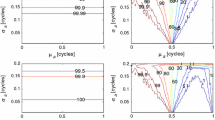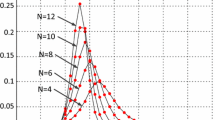Abstract
Frequency diversity is expected to benefit the ambiguity resolution (AR) with the modernization of global navigation satellite system. As one classic AR method, triple-carrier AR (TCAR) is quite computation efficient for AR by exploring the geometric consistency between the code and phase observations. However, it is difficult for the classical TCAR method to support the safety-critical applications because of insufficiently controlling false alarm and missed detection errors simultaneously. In order to monitor the effect of an unknown bias on ambiguity validation, an integrity monitoring method is developed to test the correctness of TCAR in ambiguity domain. The proposed integrity monitoring method uses double test statistics to satisfy the required probabilities of false alarm and missed detection. The simulated as well as real observed BDS triple-frequency data are used to evaluate the performance of the proposed method. The static results show that the proposed method not only is capable of constraining the false alarm and missed detection errors simultaneously, but also can control the moving average length over multiple epochs. The kinematic experiment reveals that the proposed method can achieve a comparable positioning accuracy and continuity improvement of 9 %, when compared to the geometry-based LAMBDA method with fixed detection threshold.










Similar content being viewed by others
References
Brack A, Günther C (2014) Generalized integer aperture estimation for partial GNSS ambiguity fixing. J Geod 88(5):479–490
Dong D, Bock Y (1989) Global positioning system network analysis with phase ambiguity resolution applied to crustal deformation studies in California. J Geophys Res 94(4):3949–3966
Feng Y (2008) GNSS three carrier ambiguity resolution using ionosphere-reduced virtual signals. J Geod 82(12):847–862
Henkel P, Günther C (2012) Reliable integer ambiguity resolution: multi-frequency code carrier linear combinations and statistical a priori knowledge of attitude. Navigation 59(1):61–75
Hewitson S (2003) GNSS receiver autonomous integrity monitoring: a separability analysis. Proceeding ION GPS/GNSS 2003, Institute of Navigation, Portland, 9–12 Sept, pp 1502–1509
Jung J (1999) High integrity carrier phase navigation for future LAAS using multiple civilian GPS frequencies. ION GPS 1999, Institute of Navigation, Nashville, 14–17 Sept, pp 727–736
Khanafseh S, Pervan B (2011) Detection and mitigation of reference receiver faults in differential carrier phase navigation systems. IEEE Trans Aero Electron Syst 47(4):2391–2404
Leick A, Rapoport L, Tatarnikov D (2015) GPS satellite surveying, 4th edn. Wiley, New York
Li B, Verhagen S, Teunissen PJG (2014) Robustness of GNSS integer ambiguity resolution in the presence of atmospheric biases. GPS Solut 18(2):283–296
Li L, Li Z, Yuan H, Wang L, Hou Y (2016) Integrity monitoring-based ratio test for GNSS ambiguity validation. GPS Solut 20(3):573–585
Misra P, Enge P (2006) Global positioning system: signals, measurements and performance, 2nd edn. Ganga-Jamuna Press, Massachusetts
Parkinson B, Spilker J, Axelrad P, Enge P (1996) Global positioning system: theory and applications, vol II. American Institute of Aeronautics and Astronautics Inc, Washington
Rife J, Khanafsen S, DeLorenzo D, Kim U, Koeing M, Chiou T, Kempny B, Pervan B (2008) Navigation, interference suppression, and fault monitoring in the sea-based joint precision approach and landing system. Proc IEEE 96(12):1958–1975
Teunissen PJG (1995) The least-squares ambiguity decorrelation adjustment: a method for fast GPS integer ambiguity estimation. J Geod 70(1):65–82
Teunissen PJG (1998) Success probability of integer GPS ambiguity rounding and bootstrapping. J Geod 72(10):606–612
Teunissen PJG (2001) Integer estimation in presence of biases. J Geod 75(1):399–407
Teunissen PJG (2002) The parameter distributions of the integer GPS model. J Geod 76(1):41–48
Teunissen PJG (2003) Integer aperture GNSS ambiguity resolution. Artif Satell 38(3):79–88
Teunissen PJG (2004) Penalized GNSS ambiguity resolution. J Geod 78(4–5):235–244
Teunissen PJG (2005a) GNSS ambiguity resolution with optimally controlled failure-rate. Artif Satell 40(4):219–227
Teunissen PJG (2005b) Integer aperture bootstrapping: a new GNSS ambiguity estimator with controllable fail-rate. J Geod 79:389–397
Teunissen PJG, Joosten P, Tiberius C (2001) A comparison of TCAR, CIR and LAMBDA GNSS ambiguity resolution. ION GPS 2002. Institute of Navigation, Portland, pp 2799–2808
Verhagen S, Teunissen PJG (2006) New global navigation satellite system ambiguity resolution method compared to existing approaches. J Guid Control Dyn 29(4):981–991
Verhagen S, Teunissen PJG (2013) The ratio-test for future GNSS ambiguity resolution. GPS Solut 17(4):535–548
Vollath U, Birnbach S, Landau L, Fraile-Ordoñez JM, Martí-Neira M (1999) Analysis of three-carrier ambiguity resolution technique for precise relative positioning in GNSS-2. Navigation 46(1):13–23
Wang L, Verhagen S (2014) A new ambiguity acceptance test threshold determination method with controllable failure rate. J Geod 89(4):361–375
Zhang X, He X (2016) Performance analysis of triple-frequency ambiguity resolution with BeiDou observations. GPS Solut 20(2):269–281
Zhang J, Wu M, Li T, Zhang K (2015) Integer aperture ambiguity resolution based on difference test. J Geod 89(7):667–683
Zhao Q, Dai Z, Hu Z, Sun B, Shi C, Liu J (2015) Three-carrier ambiguity resolution using the modified TCAR method. GPS Solut 19(4):589–599
Acknowledgments
The authors would like to thank GNSS Research Centre of Curtin University (Australia) for providing BDS triple-frequency data, and Mr. Yongli Gao, Mr. Yuhu Xiao (both from Beijing BDStar Navigation Co., Ltd, China) for their support during the kinematic data collection. This research was jointly funded by National Natural Science Foundation of China (Nos. 61304235, 61633008, 61273081, 61304234), the Fundamental Research Funds for Central Universities (No. HEUCF160416) and the Post-Doctoral Scientific Research Foundation, Heilongjiang Province (Nos. LBH-Q15033, LBH-Q14054).
Author information
Authors and Affiliations
Corresponding author
Appendix: optimal detection power of the proposed test method
Appendix: optimal detection power of the proposed test method
Based on (22), according to Neyman–Pearson lemma, if
can be satisfied to reject the bias-free hypothesis, the probability of missed detection can be minimized, which means the detection power is maximized. Rearranging (30), we have
The proposed integrity monitoring method is based on the following test,
If (32) is satisfied, the bias-free hypothesis is rejected. If the proposed integrity monitoring method is consistent with the Neyman–Pearson lemma, then
should be met. In order to make sure at least the real value of y in (33) exists,
needs to be satisfied. If there is a k value satisfying \(k \le \exp (0.5u^{2} )\), the proposed integrity monitoring method can obtain minimum missed detection error.
Rights and permissions
About this article
Cite this article
Li, L., Jia, C., Zhao, L. et al. Integrity monitoring-based ambiguity validation for triple-carrier ambiguity resolution. GPS Solut 21, 797–810 (2017). https://doi.org/10.1007/s10291-016-0570-9
Received:
Accepted:
Published:
Issue Date:
DOI: https://doi.org/10.1007/s10291-016-0570-9




